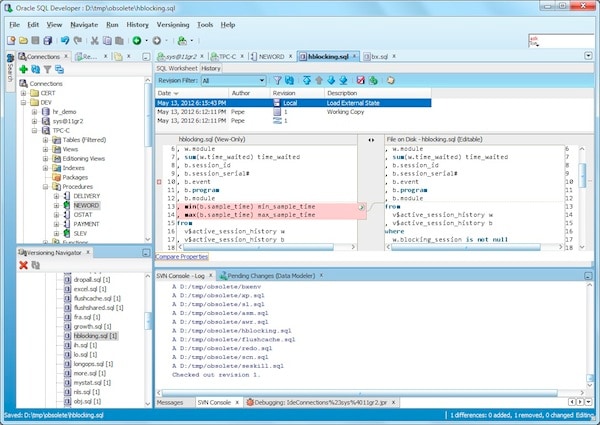

- Oracle sql developer query result window how to#
- Oracle sql developer query result window update#
- Oracle sql developer query result window full#
If you need to export your query output to a CSV file, you may then check the following guide that explains the steps to export your query results to CSV in SQL Developer. You can choose to export your query results to either the xlsx format for newer versions of Excel, or the xls format for previous versions of Excel. You can also run any number of provided reports, as well as. With SQL Developer, you can browse database objects, run SQL statements and SQL scripts, and edit and debug PL/SQL statements.
Oracle sql developer query result window how to#
You just saw how to export your query output to Excel in SQL Developer. Oracle SQL Developer is a graphical tool that enhances productivity and simplifies database development tasks. Press on the ‘ Next >‘ button once you are doneįor the final step, click on the ‘ Finish‘ button to export the query output to Excel.Click on the ‘ Browse…‘ button to select the location where the Excel file will be saved What Other Functionality Does SQL Developer Have for DBMSOUTPUT Clear you can clear the results from the output window by clicking this button.You can choose the xlsx format for recent versions of Excel, or the xls format for previous versions of Excel Select the Excel format from the drop-down list. To view the results of a query in Oracle SQL Developer, we have two possibilities: View as Grid (F9 key) Run the script (F5 key) In the first case SQL Developer.Step 3: Select the Excel format and the location to export your file Right-click on any cell on the query results, and then select the ‘ Export…‘ option from the drop down menu. Once you’re done running the query in SQL Developer, you’ll see the query output at the bottom of your screen. You can run any query based on your needs. To start, you’ll need to run your query in SQL Developer. Steps to export query output to Excel in SQL Developer Step 1: Run your query If so, you’ll see the complete steps to accomplish this goal. The parent query of the browser generates a list of tables defininition in a data model, and the child reports will include the column details (in default table style), the constraints detail (in default table style), and the DDL (sql) that I would like to make it a script style, so that I can include mutiple statements in the child report query instead of using the union to combine multiple statements (order of each statement output is not allowed and using in-line table is not possible either for some queries due to limitation of T-SQL).Do you need to export your query output to an Excel file in SQL Developer? The browser accesses the repository of the data mdeler directly and it is based on a SQL Server. The data model is defined in a data modeler system. Here are some background info: I am developing a data model browser in SQL Developer using the reports feature.

How to make a child report in style of ‘Script’, rather than the default ‘Table’? Tried to export the XML file and then edit, however, it generates error message such as ‘SQL Error: Invalid parameter index 1.’ Also as stated previously, the behavior is intermittent. The select statement at the end seems to show the rolled back state of the table even though the select happens before the rollback. SET next_index_due_date = TO_TIMESTAMP (’′, ‘DD/MM/YYYY’), JOIN client_acct_rltnshp ON carb_id = car_id The entire script is run by selecting all (Ctrl + a) and then (Ctrl + Enter)
Oracle sql developer query result window update#
There is one select followed by an insert statement, 6 update queries and then the same select once again – followed by rollback. Run Script runs the contents of the worksheet (or what’s highlighted) as a ‘script.’ What does that mean exactly? Think of this as being equivalent to running this in SQL*Plus:
Oracle sql developer query result window full#
Scroll down, or hit Ctrl+End to force a full fetch and get all your rows back. You’ll then see most of your ad hoc queries complete with a single fetch. Every query ran will come back with the first 500 rows, and rows will be continued to be fetched in 500 row increments. To alleviate this, increase your fetch size to 500. The process on the server that was used to execute the query is still hanging around too. The user sees 50, 100, 500, etc rows come back, but SQL Developer and the database know that there are more rows waiting to be retrieved. Run statement brings your query results to a grid with a single fetch. Ok, before I went on the Fetch tangent, I said there were two ways to run statements in SQL Developer: Run Statement If you have a 10 row query or a 1,000,000 row query, this can mean 1 or many fetches in groups of records. But, to get the data back to the user, the fetch must occur.

Technically it has to do at least 2 things, and sometimes only 1. What is Fetch?Īfter you run send your query to Oracle, it has to do 3 things: But there are some other, more subtle differences here, primarily around fetching. There are some obvious differences between the two features, the most obvious being the format of the output delivered.


 0 kommentar(er)
0 kommentar(er)
